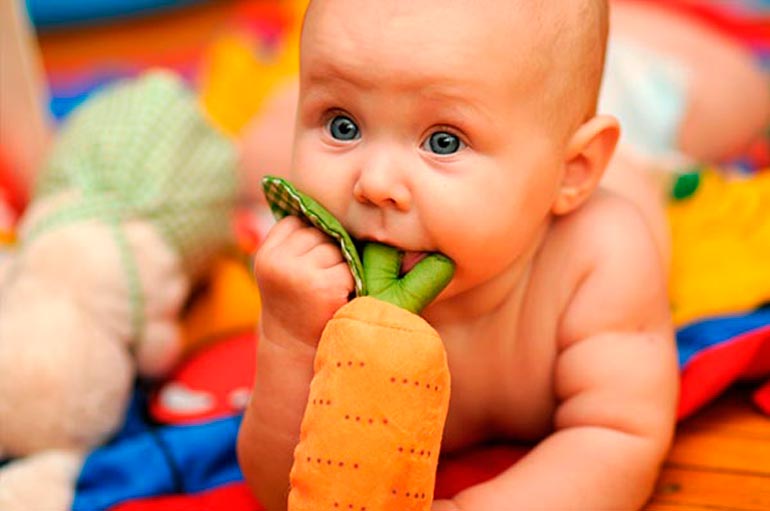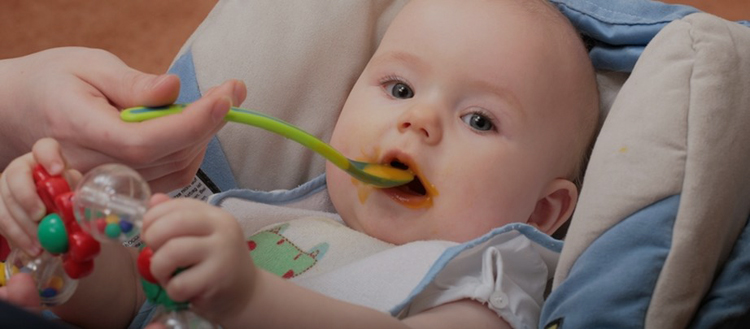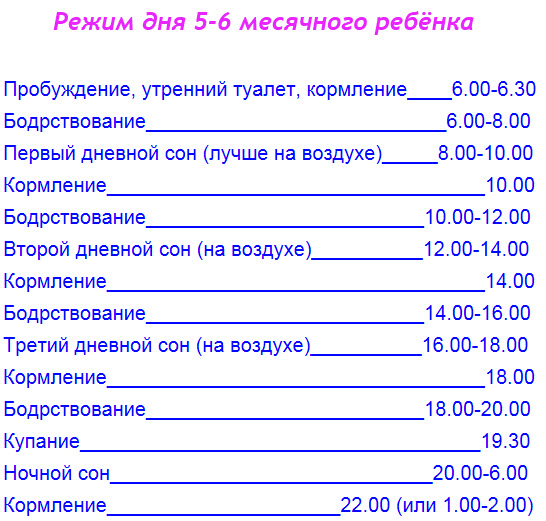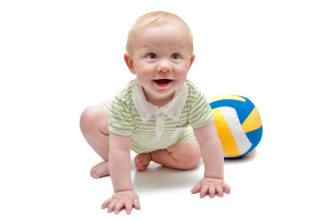The mode of the child’s day at 5 months is almost identical to the one to which all the regimen moments of his life in the previous month were subordinated. The duration of periods of sleep and wakefulness, the number of feedings remain the same, only the baby changes: every day he becomes more mobile, stronger and more curious.

Table with an approximate daily routine
- 6:00-8:00 Awakening the baby, morning feeding, followed by mandatory hygiene procedures, air baths, light massage, communication with mom;
- 8:00-10:00 The first dream combined with a walk in the fresh air;
- 10:00-12:30 Second feeding, gymnastics, massage, active wakefulness.
- 12:30-14:30 Daytime sleep.
- 14:30-17:00 The third meal, active leisure, filled with educational games and physical exercises.
- 17:00-19:00 Sleep in the fresh air.
- 19:00-21:30 The fourth feeding, developing leisure, communication with family members, bathing crumbs.
- 22:30 The last meal.
- 23:00-6:00 Sleep until morning.
Another variant:
After reviewing this schedule, each mother can adjust it to the individual needs of her five-month-old baby.
Parents of crumbs should be prepared for the fact that at five months he may appear first teeth. This significant event can manifest itself in different ways: for some babies it does not cause much pain, while others react to it with an increase in temperature, constant moods, upset stools and disturbed sleep patterns. For some time, this can cause unpredictable behavior of a sick baby, fraught with non-observance of the usual daily routine..
Fortunately, such periods are quite short-lived. After teething, mother should take care of the return of crumbs to the previous regime.
Sleep
A five-month-old baby’s night sleep is usually strong: a tightly-reinforced baby is able to sleep for about ten hours without requiring feeding and without disturbing sleeping parents. To achieve this result, the mother must properly organize the day's rest of her baby, breaking it into three two-hour periods:
- The baby needs the first sleep after two hours of morning wakefulness. If weather conditions are favorable, mom can go for a walk with him, because it is in the morning that sleeping in the fresh air will be most favorable for him.
- The second crumbs sleep in the afternoon. In the warm season, and it can be combined with a walk.
- The third time the child should be laid in the evening hours. At this moment, a dad who has returned from work can go for a walk with the baby.
It is this regimen of daytime sleep that pediatricians consider optimal for the child. If the baby has broken up, exceeding the allotted two-hour limit, you should carefully wake him up so as not to get out of the usual daily routine.

On the topic of sleep:
- How to put a child to sleep without tears and vagaries -https://kid.htgetrid.com/en/psihologiya-detey/kak-ulozhit-rebenka-spat-bez-slez-i-kaprizov.html;
- We teach a child to sleep in his crib separately from his mother (video, real stories) - https://kid.htgetrid.com/en/razvitie-rebenka-do-goda/kak-priuchit-rebenka-spat-otdelno.html;
- Whether to rock the child before bedtime: to what age can you rock the child -https://kid.htgetrid.com/en/razvitie-rebenka-do-goda/kak-ukachat-rebenka-spat.html;
- The child sleeps only in the arms, but put it wakes up - a problem or not -https://kid.htgetrid.com/en/eto-polezno-znat/rebenok-spit-na-rukah.html;
- At what age can a child sleep on a pillow -https://kid.htgetrid.com/en/razvitie-rebenka-do-goda/s-kakogo-vozrasta-rebenku-mozhno-spat-na-podushke.html.
Feed
At 5 months, the baby should eat at least a liter of breast milk per day. During feeding, he no longer sleeps, but very actively sucks his chest. It is at this age that the baby should gradually be weaned from the habit of falling asleep exclusively in the mother's breast. Each period of daytime sleep should now begin not with feeding, but with motion sickness.
An exception should be made before laying the crumbs at night: at this moment, mother's breasts will not only be a source of nutrition for him. Having calmed down quickly, the baby will sleep especially soundly.
Five-month-old breast-fed infants still do not need to be fed: they are quite satisfied with the nutrients that are found in breast milk. There are times when the baby’s mom’s milk does not eat up and therefore often gets naughty and almost does not gain weight. This situation is the basis for its transfer to mixed feeding using dairy-free cereals. After some time, porridge can be made dairy.

If complementary foods were introduced into the diet of an artificer’s child already at the age of four months, the schedule of his nutrition will look as follows:
- 6:00 Feeding with kefir or milk formula (200 ml).
- 10:00 Feeding: milkless porridge (150 ml), cottage cheese (40 g), vegetable juice (100 ml). Porridge can be rice, buckwheat or corn.
- 14:00 Feeding with vegetable soup or mashed potatoes, zucchini or cauliflower, seasoned with a drop of vegetable oil (150 ml).
- 19:00 Feeding with milk formula (200 ml).
- 22:30 Feeding with kefir or a mixture (200 ml).
We also read: we introduce feeding to the child on IV
Introducing new products into the crumbs diet, you should monitor its stool and condition of the skin: when rashes appear and the nature of bowel movements changes, they must be immediately abandoned.
We walk
The frequency and duration of walks mainly depends on weather conditions. On cold days, you can walk with your baby for no more than forty minutes, on warm days - up to several hours.
With an ideal set of circumstances, all periods of daytime rest can be combined with walks, since the active supply of oxygen improves sleep quality: it becomes longer and deeper.
During walks, it is necessary to familiarize the baby with objects and phenomena of the world, accompanying everything seen with simple comments that are accessible to his understanding.
Are developing
At the age of five months, the child masters a whole range of skills. He can:
- Recognize loved ones and your own reflection in the mirror;
- Rejoice in the mother's voice;
- Reach for the object you like, grab and take it away;
- Press the keys and buttons of musical instruments;
- Play with a rattle and a squeaker;
- Inspect the shape and texture of objects, feeling them with pens;
- Pull in your mouth your arms / legs and everything that comes into his arm;
- Keep an eye on the subject, turning his head in any direction;
- Independently roll over from the back to the barrel, and then to the tummy. Roll over in the opposite direction is also not a big deal for him;
- For a long time to lie on his tummy, looking at the surroundings;
- Leaning on the head and knees, raise the pelvis and torso;
- To make the first attempts to independent sitting (When does the baby begin to sit down on his own?);
- Clutching the adult's fingers tightly, rise and occupy an upright position.
Do not force the development of the baby, forcing him to perform actions that the child of a close friend has already mastered. Five-month-old children develop completely individually: today he does not know much, and a week later he can master several skills at once, leaving the "opponent" far behind. The key to successful development of the baby are daily activities with mom.
We also read: 5 month baby skills
Games and activities
For the successful development of crumbs in five months, you can purchase several colorful toys equipped with a set of sound effects. The most useful for him will be:
- Stuffed toys with sewn tweeters, hard balls, foil inserts;
- Baby drums and multi-color rattles;
- Bright nesting dolls;
- Puppet for finger theater;
- Voiced soft animals, performing songs and tales;
- Children's musical instruments (piano, metallophone). A full replacement for such tools can be spoons, a pan with a lid, etc.
What should be the content of developmental activities?
A five month old baby is very smart and inquisitive. He already understands what it means “Not allowed”, correctly responds to the words: “give”, “on”, “go to mom”. Understanding the baby is available in different intonations: with gentle treatment, he will smile, and in response to a grouchy remark, can cry.
[sc: rsa]
- You should continue reading books, looking at pictures. You can show photos of family members and talk about them;
- Telling the baby poetry and nursery rhymes, it is very useful to stroke, knead and rub his tiny fingers: such a massage will help improve blood circulation, activate speech centers and stimulate the functioning of internal organs. To perform the massage, the mother can use a walnut, ball or pencil, rolling them between the children's hands or on the outer surface of the hands;
- Wanting to amuse the crumbs, you can grab it in your arms and let it fly "by plane." No less delight will be the opportunity to jump on the lap of someone from the house;
- Going around the apartment with the crumbs in his hands, you must continue to acquaint him with the names of the objects in it;
- You can introduce the crumbs not only to the different texture of the material, but also to the difference in physical properties by letting them touch a piece of ice or a mug of warm tea;
- It is necessary to talk with the child as much as possible, trying to clearly and correctly pronounce the words, remembering that they are deposited in his memory, creating a passive vocabulary.
Gymnastics and physical development
The child’s leisure should be active, so care must be taken in advance to provide him with a free and safe space for performing physical exercises (we read an article on how to secure a house for a child).
- It is very important to teach the baby to crawl. Having laid the child on the floor and putting his palms under the small heels, it is necessary to give him the opportunity to push off and make the first attempts to move forward (when the baby begins to crawl);
- Gymnastic exercises with a large ball are incredibly useful for a baby, which improve stretching and strengthen the musculo-ligamentous apparatus (read about the right fitball exercises);
- A baby who has not yet learned how to turn over from his back to his tummy on his own should be constantly encouraged to do this by placing his hand under the barrel or putting his favorite toy nearby;
- One can only welcome the desire of many parents to teach their kids to swim. Regular exercise in the pool helps to expand the lungs and improve coordination of movements. Kids who can swim begin to walk faster. The duration of swimming loads should be no more than ten minutes. To make the kid happy, it is necessary to turn the process into an exciting game using brightly voiced toys.After swimming, you need to do a tiny relaxing massage.
We also read: 5 month baby development
The reasons for the violation of the daily routine and how to overcome them
Most often, failures in sleep and nutrition of a five-month-old baby occur due to fault:
- teething first teeth.
- too active introduction of new complementary foods in the diet.
To alleviate the condition of the crumbs, capricious during the teething period, you can use special teething toysintended for massage of swollen and itchy gums.
If the cause of childhood vagaries is a violation of the rules for the introduction of complementary foods, you should temporarily completely eliminate the problem product from the baby’s diet. After a few days, you can try to enter it again, but in very small portions, carefully looking at the reaction of the child’s body.
Since the baby, still not able to speak, reports of unmet needs with an exceptionally loud cry (read an article on how to understand the causes of crying children), a caring mother should establish and eliminate its cause as soon as possible (crying may be due to lack of attention, hunger, severe overwork).
A well-planned daily routine for a baby of 5 months is a guarantor of the well-being of the child, disciplining his behavior and stimulating the success of physical and intellectual development.
← 4 months daily routine 6 months daily routine →
Video guide: 5 months old baby
http://www.youtube.com/watch?v=ep7JjEB_ids
***
http://www.youtube.com/watch?v=v4NGxUm_jV0
***
http://www.youtube.com/watch?v=WkKeOBxDtRw










Oh, if it were so easy to observe these modes. My son is breast-fed, sleeps once a day for half an hour, although he is only half a year old. And it is impossible to force, even on the street does not sleep)
We had a little different, so, until I forgot such a wonderful age. The teeth are cut in all children differently and quite often give temperature and irritability. As a result, we did not get enough sleep from the word “completely” and it was simply impossible to adhere to any clear regime. So it was convenient to slightly shift the charts of daytime sleep, that is, the first dream from 11 to 13, and the second somewhere from 17 to 18, and so on until the teeth were cut, each time.
I largely agree with the above! I think that for a child, and for mom, having your own regimen is good! It makes life a lot easier. A child must learn from childhood to develop habits for everything. The main thing is that without fanaticism!
Hahaha, when she was pregnant, read such articles and thought that everyone was complaining about it, it was so simple with the children, put it on for 2 hours and go about your business.
The result - we are now 5 months old, sleeping in the afternoon 2 times for 30 minutes only with breasts in the mouth, and once for a walk for 2-3 hours. For the second time, he doesn’t sleep in a stroller if he immediately shakes his hands with a scandal 😀 and at night every 3 hours. All adults are different, respectively, and the kids too!
I liked the article, but not all. Complementary feeding begins at six months, it has already been proven. There is a supplement mixture if there is not enough milk. Especially as it says here you can ditch the child. All fermented milk products can be started not earlier than 9 months. Not to mention the soup, where there is not a small number of products at once. At six months, they begin to acquaint the child with food, and these are fruits and vegetables, and then drop by drop and increasing the dose after seeing what kind of reaction the child has. A new product no earlier than three days.